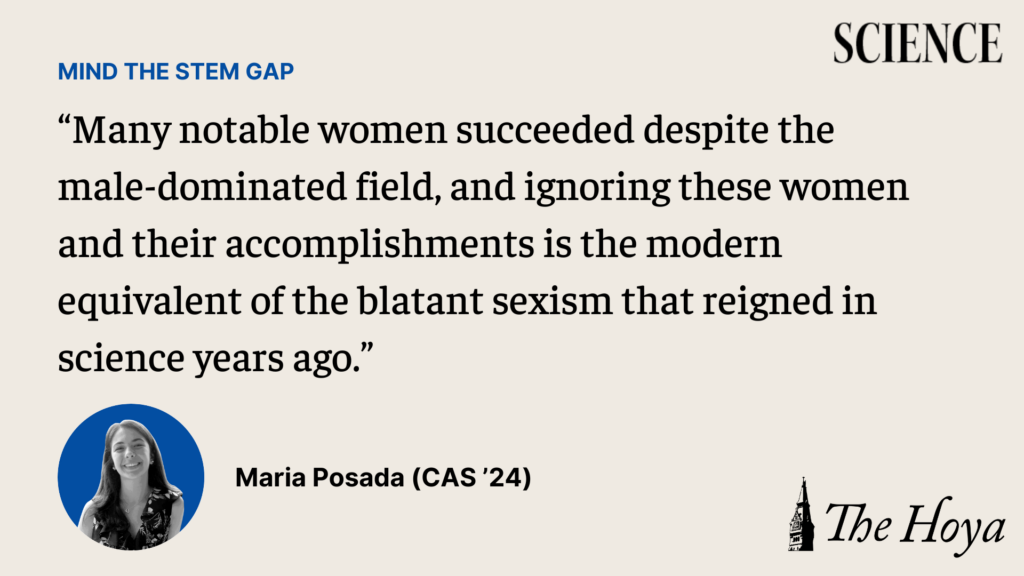Every semester, I flip through my science class syllabi and am met with the same familiar pattern: pages and pages filled with the names of male scientists.
At first, I perceived the absence of women in science syllabi as a sign that they were not involved in the history of major scientific advances, but this is not the case. Many notable women succeeded despite the male-dominated field, and ignoring these women and their accomplishments is the modern equivalent of the blatant sexism that reigned in science years ago. Science classes at Georgetown University need to teach about more women in science.
The abhorrent notion that women did not make significant contributions in science is far from the truth. Many female scientists, including Mary Anning, Elizabeth Blackwell and Margaret Oakley Dayhoff, made impressive breakthroughs and innovated science in fields dominated by men.
Most of women’s contributions to science remain lost to history, however. Our classes at Georgetown have a responsibility to spotlight these historically forgotten women, elevating their scientific discoveries and providing new generations of women scientists with representative role models.
Highlighting the achievements of women scientists helps fight against misconceptions. These women and their achievements show the scientific community that the sciences are not only for men, and help break down the misconception that women are not as successful or impactful as scientists as men.
Women should not have to wait for trending movies such as “Hidden Figures” and “Radioactive” to shine a light on these scholars. I’m not saying female scientists need celebrity status — after all, scientists are rarely household names. But when you ask someone to name 5 scientists, those names should not all belong to men, and the women mentioned should not be limited to Marie Curie and Rosalind Franklin. The first step to equity among the sexes is to teach about women in our classes and read about them in books just the same as their male counterparts.
Such education starts here. One example of a historically forgotten female scientist is Mary Anning. Anning was a ‘fossil hunter’ in the early-to-mid 19th century whose discoveries helped revolutionize our knowledge of marine Jurassic species.
Although she was clearly a pioneer in paleontology, Anning never received the recognition she deserved. Despite these major findings, Anning died in debt with little to no recognition and was never admitted to the Geological Society of London, where her male contemporaries were members. We have a responsibility to give her a voice many years later by highlighting her work in geoscience and evolution classes.
Another woman whose story should be incorporated into Georgetown’s science curricula is Dr. Elizabeth Blackwell. Blackwell was born in England and moved to the U.S. at 11, where she dove head first into advocating for abolition. Blackwell initially trained as a teacher and had no interest in pursuing a career in medicine, until speaking to a dying family friend who expressed that there was a crisis in patient care in America. In 1849, Blackwell became the first woman to graduate from medical school in the United States. Blackwell spent her life advocating both for women’s healthcare and the importance of women doctors in improving patient care.
Blackwell also founded the New York Dispensary for Poor Women and Children, which provided a space for women to practice medicine in a time where most practices and hospitals did not accept them. The hospital provided high-quality medical and surgical care to families struggling financially. For those interested in becoming healthcare professionals, we have Blackwell to thank for opening the door for the many years of female doctors at Georgetown and beyond.
At Georgetown, Margaret Oakley Dayhoff broke several boundaries. Dayhoff worked at the Georgetown Medical Center during the 1970s, and revolutionized the field of bioinformatics by applying mathematics and computational techniques to protein sequencing. One of Dayhoff’s major contributions was the Protein Information Resource, which is the online database containing a collection of all known protein sequences.
Dayhoff also invented the single letter amino acid code, which significantly reduced the data file size needed to code amino acid sequences. These are all techniques which are central to several biology courses, but Dayhoff is rarely, if ever, credited in these classes despite the fact that she worked right here at Georgetown. Incorporating Dayhoff’s role in the curricula of classes with a molecular or evolutionary focus would serve not only to credit her for creating technology and a letter coding system we use everyday, but also to remind us of the incredible science that happened right here at Georgetown.
While these are only three examples of women whose recognition has been lost to history, there are countless women who helped progress the scientific field whose names are lost to history. It is vital that we learn about these women in our classes at Georgetown to elevate their stories and discoveries.
Women have always, and will always, play a vital role in science.









